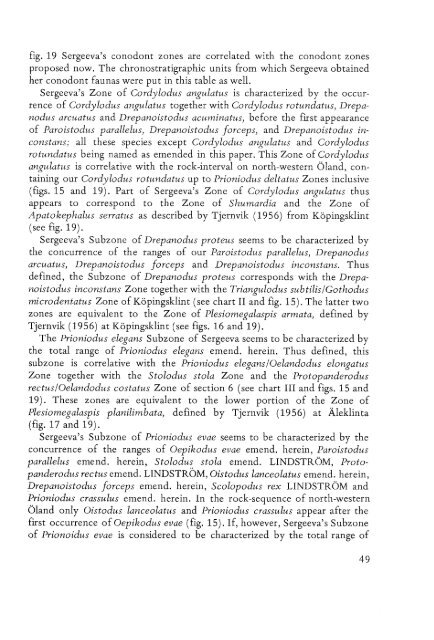UTRECHT MICROPALEONTOLOGICAL BUllETINS
UTRECHT MICROPALEONTOLOGICAL BUllETINS
UTRECHT MICROPALEONTOLOGICAL BUllETINS
Create successful ePaper yourself
Turn your PDF publications into a flip-book with our unique Google optimized e-Paper software.
fig. 19 Sergeeva's conodont zones are correlated with the conodont zones<br />
proposed now. The chronostratigraphic units from which Sergeeva obtained<br />
her conodont faunas were put in this table as well.<br />
Sergeeva's Zone of Cordylodus angulatus is characterized by the occurrence<br />
of Cordylodus angulatus together with Cordylodus rotundatus, Drepanodus<br />
arcuatus and Drepanoistodus acuminatus, before the first appearance<br />
of Paroistodus parallelus, Drepanoistodus forceps, and Drepanoistodus inconstans;<br />
all these species except Cordylodus angulatus and Cordylodus<br />
rotundatus being named as emended in this paper. This Zone of Cordylodus<br />
angulatus is correlative with the rock-interval on north-western Oland, containing<br />
our Cordylodus rotundatus up to Prioniodus deltatus Zones inclusive<br />
(figs. 15 and 19). Part of Sergeeva's Zone of Cordylodus angulatus thus<br />
appears to correspond to the Zone of Shumardia and the Zone of<br />
Apatokephalus serratus as described by Tjernvik (1956) from Kopingsklint<br />
(see fig. 19).<br />
Sergeeva's Subzone of Drepanodus proteus seems to be characterized by<br />
the concurrence of the ranges of our Paroistodus parallelus, Drepanodus<br />
arcuatus, Drepanoistodus forceps and Drepanoistodus inconstans. Thus<br />
defined, the Subzone of Drepanodus proteus corresponds with the Drepanoistodus<br />
inconstans Zone together with the Triangulodus subtilis/Gothodus<br />
microdentatus Zone of Kopingsklint (see chart II and fig. 15). The latter two<br />
zones are equivalent to the Zone of Plesiomegalaspis armata, defined by<br />
Tjernvik (1956) at Kopingsklint (see figs. 16 and 19).<br />
The Prioniodus elegans Subzone of Sergeeva seems to be characterized by<br />
the total range of Prioniodus elegans emend. herein. Thus defined, this<br />
subzone is correlative with the Prioniodus elegans/Oelandodus elongatus<br />
Zone together with the Stolodus stola Zone and the Protopanderodus<br />
rectus/Oelandodus costatus Zone of section 6 (see chart III and figs. 15 and<br />
19). These zones are equivalent to the lower portion of the Zone of<br />
Plesiomegalaspis planilimbata, defined by Tjernvik (1956) at Aleklinta<br />
(fig. 17 and 19).<br />
Sergeeva's Subzone of Prioniodus evae seems to be characterized by the<br />
concurrence of the ranges of Oepikodus evae emend. herein, Paroistodus<br />
parallelus emend. herein, Stolodus stola emend. LINDSTROM, Protopanderodus<br />
rectus emend. LINDSTROM, Oistodus lanceolatus emend. herein,<br />
Drepanoistodus forceps emend. herein, Scolopodus rex LINDSTROM and<br />
Prioniodus crassulus emend. herein. In the rock-sequence of north-western<br />
Oland only Oistodus lanceolatus and Prioniodus crassulus appear after the<br />
first occurrence of Oepikodus evae (fig. 15). If, however, Sergeeva's Subzone<br />
of Prionoidus evae is considered to be characterized by the total range of
















